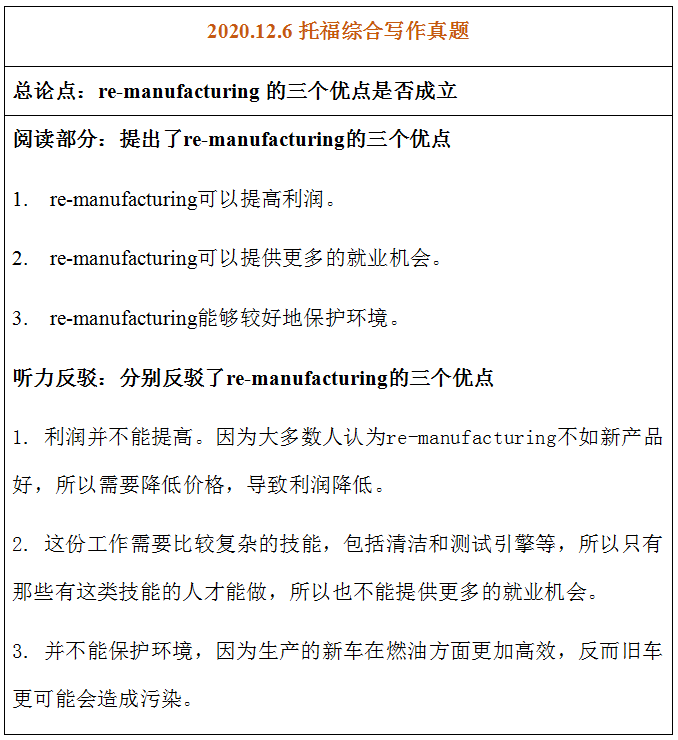
作者:北美考试院 托福写作组 张晟凯

解题思路:
此题是阅读材料提出某个事物的三个优点,而听力材料分别反驳这三个优点的综合写作题型,需要考生抓住听力中反驳的要点,并在文章中进行尽可能详尽的复述。
本题考查的话题属于托福综合写作中占比极大的自然学科类话题,探讨的是“re-manufacturing的三个优点是否成立”。在TPO中有大量题目涉及到了自然学科类话题,如TPO20、TPO21、TPO22、TPO23、TPO37、TPO39、TPO42、TPO46等。考生可适度选择上述提到的TPO材料,熟悉相关话题,分析材料结构和写作结构。
可以类比TPO 46的综合写作:电子医疗记录的三个优点是否成立
TPO 46 综合写作
阅读部分:电子医疗记录有三个优点
Main idea: Storing patients’medical records in electronic databases have several advantages over traditional paper-based record keeping.
· The use of electronic records can help reduce costs by saving money on storing and transferring medical records. 使用电子记录可以节省存储和传输医疗记录的费用,从而有助于降低成本。
· Electronic medical records are crucial to reducing the chances of medical errors. 电子病历对于减少医疗错误非常关键。
· Electronic medical records can greatly aid medical research by making it possible to gather large amounts of data from patient records. 电子病历可以收集大量的数据,有助于医学研究。
听力反驳:电子医疗记录的三个优点并不成立
Main idea: The benefits are actually very uncertain.
· Doctors who adopt electronic records still use the paper records for an emergency backup or for legal reasons. So they still have to pay storage costs associated with paper-based record keeping. 采用电子记录的医生仍将纸质记录用于紧急备份或法律用途。因此,他们仍然需要支付与纸面记录相关的存储成本。
· Most doctors still use pen and paper while examining patients. It's usually the office staff of a doctor who entered this information at a later time. So poor handwriting can still lead to error. 大多数医生在检查病人时仍然使用笔和纸。通常是医生的办公室工作人员在以后输入这些信息。所以拙劣的笔迹仍然会导致错误。
· Access to all medical information is subject to strict privacy laws. So researchers who want to collect data from electronic medical records have to follow strict and complicated procedures and obtain many permissions along the way, which are usually not granted. 对所有医疗信息的访问受到严格的隐私法的约束。因此,研究人员要想从电子病历中收集数据,就必须遵循严格而复杂的程序,并在获取过程中获得许多权限,而这些权限通常是不被授予的。

题目解析:
12月6日的托福独立写作探讨的是是否同意观点“政府在市中心建立无车区”。这是常规的观点对立类题型,只需选择同意或反对并给出理由即可。
对于具体的文章结构和思路,范文以支持建立cars-free zones为例,给出两点理由:①无车区确实可以缓解交通堵塞;②无车区某种程度上可以解决汽车导致的噪音污染问题。两个主体段之后又加了一个让步段,即对持反对观点的人一个回应:即使建立无车区之后有些地方难以到达会不方便,但我们可以用其他交通方式来代替汽车出行。本文采用五段式的结构,开头以简单背景引起兴趣,引入话题后表达个人观点,两个理由段论述支持建立无车区的理由,让步段则回应了反对者提出的问题,结尾段总结全文并重申立场。
请参考如下范文:
Nowadays, in the wake of the rapid development of the automobile manufacturing industry, cars seem to be ubiquitous on the streets, which has become a nightmare for governments all around the world. Recently, a debatable discussion about whether governments should establish some car-free zones in the center of the city has arisen. Some people are opposed to this idea and hold the view that it will be extremely inconvenient if they cannot go somewhere by car. However, in my opinion, I firmly advocate the proposal, and my reasons are given in the following paragraphs.
First and foremost, establishing some car-free zones will undoubtedly alleviate traffic jams. As is known to all, due to the fact that traffic congestion is fundamentally caused by the abuse of cars, governments have to take coercive measures to limit car owners. Contrary to the general expectation, moderate policies such as forcing drivers to pay a fee if they attempt to drive cars do not work, since affluent car owners and those who are in a hurry to go somewhere are willing to pay the fee to drive. Hence, the only way to solve the problems is to directly prohibit driving in certain places. In that case, these forbidden zones in the center of the city will be gradually regarded as places resembling pavements which cars are never allowed to reach. Eventually, people will be accustomed to their existence, which is conducive to releasing traffic jams.
In addition, car-free zones can eliminate noise pollution caused by cars. It is obvious that cities, especially downtown areas, stand buildings that require quiet surroundings. Those who long for peace include the old wandering in the central park, the students who have to focus on their studies, the employees who need to pay much attention to their work, and diners who manage to enjoy the meals quietly. Unfortunately, parks, schools, companies, and restaurants are mostly located in the central area, which is nagged by the noise of cars. Therefore, car-free zones established in the center of the city will indeed create a quiet atmosphere free of noise produced by a myriad of cars, which may benefit a large number of citizens.
Despite the inconvenience of not being able to reach some places, people are capable of going everywhere they want in other ways, such as riding bicycles or taking subways. Cars, to some extent, are not indispensable in contemporary society in light of the developed public traffic system.
In conclusion, I believe that it is beneficial for citizens to establish some car-free zones in the center of the city. It is not only because of the release of the traffic pressure but also because of the elimination of the noise pollution. I hope every government can find its own way to deal with the increasingly difficult problems of traffic.